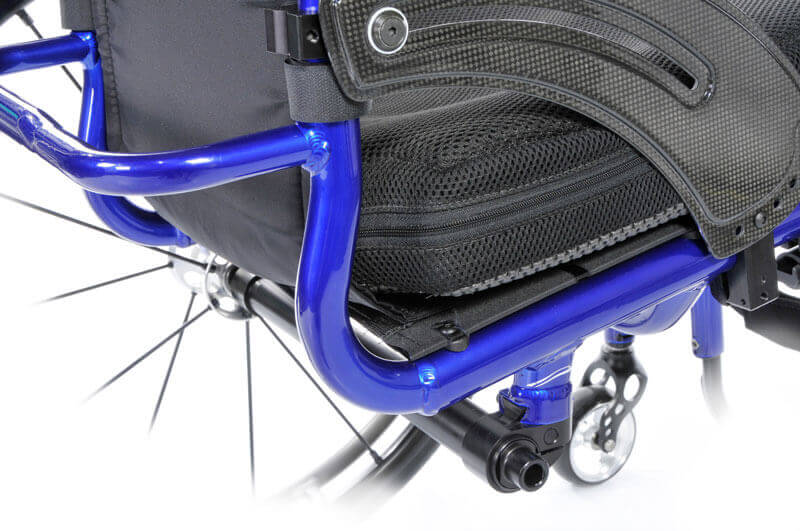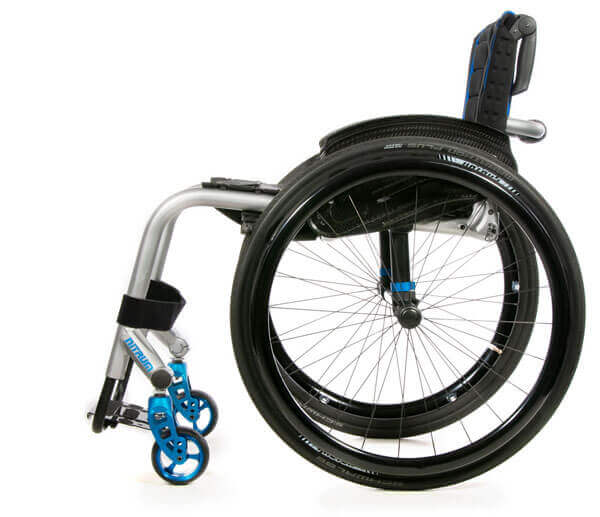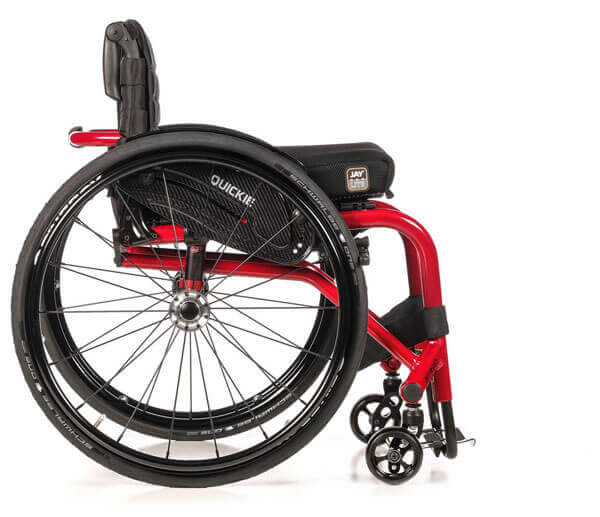Rigid frame wheelchairs are ideal for transferring energy into motion. When prescribed appropriately, a rigid frame wheelchair helps to provide a more efficient mobility solution. This blog will review the definition of a rigid frame and discuss the factors in a rigid wheelchair that contribute to optimizing movement and performance for an end-user.
Definition
Let's start with a definition of a rigid wheelchair, which is a "Frame with components under the seat that are fixed and non-foldable." (Waugh and Crane, 2013)
Rigid wheelchairs are ultra lightweight due to their overall design and the materials used. There is no cross-brace in a rigid frame wheelchair, which means that the wheelchair does not fold side-to-side. Depending on how the wheelchair is configured, the back canes may be able to fold down for transport purposes. Most rigid wheelchairs typically have a "fixed" front end, with a platform for foot positioning. However, some models of rigid wheelchairs have optional swing-away lower leg assemblies (i.e., front hangers) to allow ease of standing transfers while still providing the benefits of a rigid frame.
Typical user
A typical user of a rigid frame wheelchair is active, independent, and propels with the upper extremities. The typical user requires a wheelchair for long-term, everyday use and for activities that require some speed and maneuverability, like community use (Batavia, 2010). While some models of rigid wheelchairs allow for optional swing-away lower leg assemblies for standing transfers, most rigid wheelchair users will perform a non-standing transfer, such as a sliding board transfer or a side-to-side transfer.
Benefits of a rigid wheelchair
The efficiency of propulsion tends to be greater in a rigid frame wheelchair than in a standard or made-to-order folding wheelchair for several reasons. Rigid wheelchairs are typically manufactured of materials that are lighter in weight than standard or configured folding wheelchairs. Their sleek design also minimizes the amount of material that is used to produce the wheelchair, which further reduces the overall weight. Although these wheelchairs are very light, they are designed to be durable for the active user.
The rolling resistance is less in a rigid frame wheelchair than in a folding frame wheelchair. Rolling resistance is defined as "the force that resists the motion when an object rolls on a surface" (Wikipedia, 2020). Rolling resistance will limit the distance a manual wheelchair coasts after a force, such as from a push stroke, is applied. Several factors contribute to rolling resistance in a manual wheelchair. These factors include the combined mass of the user & the system, the weight distribution between the front casters & rear wheels, the size & type of casters & tires selected, and the surface on which the wheelchair is used. Minimizing the rolling resistance in a manual wheelchair enables more efficient propulsion by reducing the force and frequency of strokes required to propel the wheelchair. This helps to reduce the risk of upper extremity pain and injury.
In addition, a rigid wheelchair has fewer moving parts than a folding wheelchair. When an individual applies force to a rigid wheelchair's handrim, most of the energy of propulsion is directed moving the wheelchair forward, rather than being lost in the flex of the frame (which can happen in a folding frame wheelchair). This further contributes to greater efficiency of propulsion.
Similarities and differences among rigid wheelchairs
All rigid wheelchairs are made-to-order. They are manufactured to the specifications of each user, including the size, front frame angle, inset, and choice of casters, rear wheels, and tires.
Some models of rigid wheelchairs are adjustable, while others are fixed. Adjustable rigid wheelchairs may allow for changes in the rear axle or in the back angle. This option is good for an individual who may experience change over time and who may require resulting changes in the center of gravity for performance. An individual who is very experienced in using a rigid wheelchair may choose a fixed rigid frame, as they know the exact setup that optimizes their fit and performance. An active rigid chair is fully welded with few parts that can be changed in position. The active rigid back canes (shown below) are fully welded and help to transfer energy directly from the upper extremities to the axles for the most efficient propulsion.

There are other differences in rigid wheelchair frames. Some are "open" frame, while others are "closed" frame, with an additional tube extending to the caster housing. Some wheelchair users prefer the additional rigidity provided by the closed frame. Some individuals who are lifting a wheelchair across their body into a vehicle prefer an open frame design, as it provides more clearance once the rear wheels are removed.
 Open frame rigid wheelchair
Open frame rigid wheelchair
 Closed frame rigid wheelchair
Closed frame rigid wheelchair
Understanding what is required in a rigid wheelchair for an individual goes back to the assessment. The individual's goals, experience, stability of condition, activities, terrains, and positioning needs will need to be taken into account.
Why so many choices?
Even just looking at one manufacturer, there are several models of rigid wheelchairs to choose from. Why so many choices? There will never be one model of rigid wheelchair that is appropriate for everyone. As we have seen, there is a difference between an adjustable rigid wheelchair and an active rigid wheelchair. This difference speaks to the experience level of the user and the need for potential changes in the wheelchair to accommodate changes in the individual's condition. The activities the client will use the chair for, the terrain they will traverse, and their transportation needs will make one particular model of wheelchair a better choice for that client. To fulfill the needs and wants of loyal customers who love the product they have been successfully using for years, sometimes manufacturers continue to make "legacy" products despite having more recent products with new innovations on the market.
Summary
Rigid frame wheelchairs offer some choice in the type of frame – from open frame to closed frame, and from fully welded chairs to models with fold-down back canes. Some models of rigid wheelchairs provide adjustability in the rear axle, while others are fully fixed. Rigid frame wheelchairs promote efficiency of propulsion due to their lightweight design and minimization of moving parts, which allows for more efficient propulsion. A thorough assessment is required in order to match the needs of clients with the products that are available on the market for optimal fit, function, and performance.
References
- Batavia, M. (2010). The Wheelchair Evaluation (2nd. Ed.) Toronto: Jones and Bartlett Publishers
- Rosen, L.E. (2018). Manual mobility applications for the person able to self-propel. In Lange, M.L. & Minkel, J.L. (Eds.), Seating and Wheeled Mobility: A Clinical Resource Guide (pp. 149-163). Thorofare, NJ: Slack Inc.
- Waugh, K. and Crane, B. (2013). Glossary of wheelchair terms and definitions. Denver, CO. University of Colorado Denver. Retrieved from: ncart.us
- Wikipedia. (2020). Rolling resistance. Retrieved from en.wikipedia.org/wiki/Rolling_resistance
Sheilagh Sherman, BA, BHScOT, MHM, OT Reg. (Ont.) joined Sunrise Medical Canada in 2010 as our full-time Clinical Educator. Prior to joining Sunrise, Sheilagh gained extensive clinical experience from working in a variety of settings, including in-patient rehabilitation, complex continuing care, and community rehabilitation. As Clinical Educator, Sheilagh is a clinical resource for therapists across Canada involved in seating and mobility. She teaches in-services and leads workshops & seminars on the clinical aspects of seating and mobility. In addition, Sheilagh hosts monthly webinars for therapists and vendors.